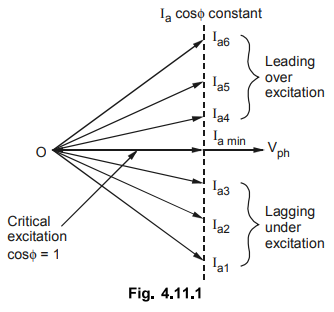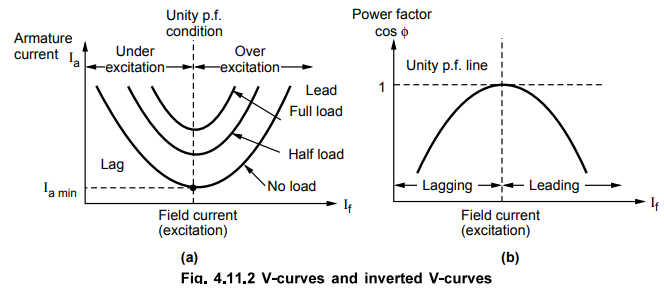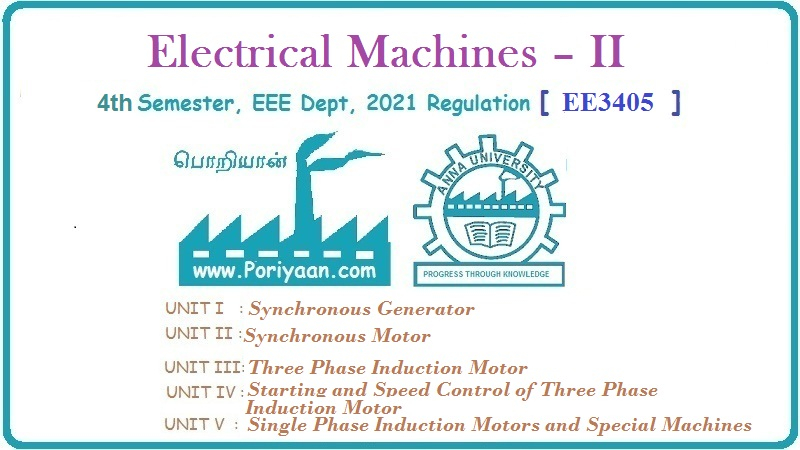Electrical Machines II: UNIT II: Synchronous Motor
V-Curves and Inverted V-Curves
Synchronous Motor
Excitation can be increased by increasing the field current passing through the field winding of synchronous motor.
V-Curves and Inverted V-Curves AU : May-06, 07, 09,
10, 11, 16, 17; Dec.-07, 10, 11, 12, 13, 14, 15, 16
From
the above discussion about variable excitation operation of motor, it is clear
that if excitation is varied from very low (under excitation) to very high
(over excitation) value, then current Ia decreases, becomes minimum at unity
p.f. and then again increases. But initial lagging current becomes unity and
then becomes leading in nature. This can be shown as in the Fig. 4.11.1.

Excitation
can be increased by increasing the field current passing through the field
winding of synchronous motor. If graph of armature current drawn by the motor
(Ia) against field current (If) is plotted, then its
shape looks like an english alphabet V. If such graphs are obtained at various
load conditions we get family of curves, all looking like V. Such curves are
called V-curves of synchronous motor. These are shown in the Fig. 4.11.2 (a).
As
against this, if the power factor (cos ϕ) is plotted against field current
(If), then the shape of the graph looks like an inverted V. Such curves
obtained by plotting p.f. against If, at various load conditions are
called Inverted V-curves of synchronous motor. These curves are shown in the Fig.
4.11.2 (b).

1. Experimental Setup to Obtain V-Curves
Fig.
4.11.3 shows an experimental setup to obtain V-curves and Inverted V-curves of
synchronous motor.

Stator
is connected to three phase supply through wattmeters and ammeter. The two
wattmeter method is used to measure input power of motor. The ammeter is
reading line current which is same as armature (stator) current. Voltmeter is
reading line voltage.
A
rheostat in a potential divider arrangement is used in the field circuit. By
controlling the voltage by rheostat, the field current can be changed. Hence
motor can be subjected to variable excitation condition to note down the
readings.

Now
IL = Ia , per phase value can be determined, from the
stator winding connections.
IL
= Iaph for star connection
IL
/ √3 = Iaph for connection
The
power factor can be obtained as

The
graph can be plotted from this result table.
1)
Ia Vs If → V-curve
2)
cos ϕ Vs If → Inverted
V-curve
The
entire procedure can be repeated for various load conditions to obtain family
of V-curves and Inverted V-curves.
Review Questions
1. Explain ‘V’ inverted ‘V’ curves of a synchronous motor.
2. Discuss in details how V curves obtained for a synchronous
motor.
Electrical Machines II: UNIT II: Synchronous Motor : Tag: Engineering Electrical Machines - II : Synchronous Motor - V-Curves and Inverted V-Curves
Related Topics
Related Subjects
Electrical Machines II
EE3405 Machine 2 EM 2 4th Semester EEE Dept | 2021 Regulation | 4th Semester EEE Dept 2021 Regulation
